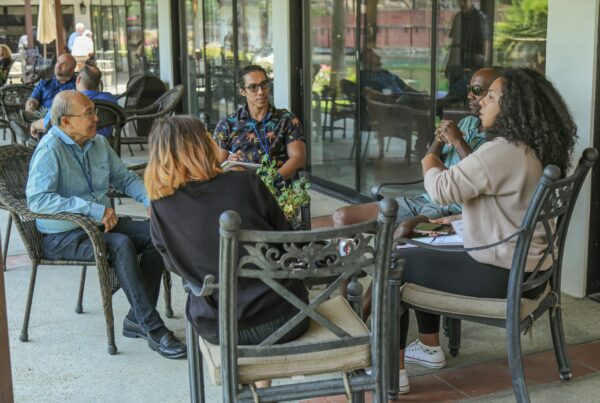Last month, Vibrant Congregations hosted Dr. Peter Watts for a conversation in which Dr. Watts presented some of the research and findings of his doctoral project, “Spiritual Formation Practices that Liberate.” This article is condensed and adapted from that conversation. Listen to the full conversation here.
M ost of my ministry career has been around church planting and working with apostolic leaders who wanted to do new work. But I began to find that, while the church is really good at helping pastors, leaders, and teams come up with strategic plans, it is really inept at making sure that leaders are actually healthy. And I began to see a lot of the different impacts of unhealthy leaders in churches, such as moral failures, abusive leadership, or ministry burnout.
Spiritual formation practices are critical for the health of church leaders
I started asking some essential questions: how can people be equipped with spiritual formation training that is contextual, while addressing the alarming, growing demographics of people who are unaffiliated with religion? How can we ensure leaders are actually healthy and pouring into their inner selves? And, lastly, how can the ethnic identity of a congregation inform the leader’s belonging and purpose?
Those are important questions for me as an African American pastor who is leading a multiethnic church in the city of Los Angeles within a denomination that has historically been predominantly white. With my doctoral work, I set out to establish good spiritual formation practices in culturally diverse neighborhoods, to develop a meaningful plan for spiritual formation that creates healthy rhythms in urban settings, and to help congregations understand their need for contextual theology. And I wanted to all do that from an African and African American perspective.
My theoretical framework contains four movements: inward, outward, together movements that move us to Spirit-empowered practices. When we think about spiritual formation or spiritual disciplines, we think about formation practices of prayer, study, and meditation. But the literature that’s published on spiritual formation does not make the connection between healthy leadership and body practices of healing, so I wanted to look at how spiritual practices might include our bodies.
People of African descent especially are body people, and I wanted to ensure that we embodied practices and spiritual formation practices that really dealt with our bodies and the trauma that we, as people of African descent, have experienced and the impact that it’s had on our bodies. How might we heal from that trauma in order to be healthy leaders in an urban context? Could our African American spiritual formation practices create thriving congregations that value and embody an inward movement toward self and God, an outward movement toward the oppressed, and a together movement toward one another?
Recent trauma and its effect on the church
Our church in Los Angeles was not a large church by any means. And when the pandemic hit, we switched to online. Then, the restrictions started to subside and people started to come back, but not everybody came back. Churches have become smaller and more remote—and there’s great stress in the system. We began to see the impact on people’s mental health, particularly on the emotional health of pastors and church leaders. Folks resigned from ministry, suicide rates begin to increase, and there was a large increase in depression among leaders. All of this was an impact of the communal trauma that happened over the past three years.
Within this context and in my research, I began to look specifically at African American believers and faith communities. And it was no different. Just like any other church in North America, the Black church was having the exact same issue. Research from Barna showed a decrease in the number of African American and Black people in North America who identify as Christian Protestant and began to identify more as spiritual and religious, or began to identify as nones, people who have no affiliation with any religion.
With the pandemic and the racial uprisings after the murder of George Floyd, we began to see an exodus of Black millennials and Gen Zs from churches that they had been attending—churches that were predominantly white or even multiethnic. On college campuses, African American millennials and Gen Zs were saying that Christianity was a tool used to brainwash Black people, that Christianity is a white man’s or oppressor’s religion, or that Christianity is an opioid used to control the masses.
So, what I found in my research was that there was a lot of racialized trauma and a lot of distrust within the institution of the mainline Evangelical church. That is why Black millennials and Gen Zs, even some boomers, were and are pulling away.
Communal crisis broadens the trauma
Because of social media and because of technology, we now experience trauma on a global level, as a global community. It’s no longer just localized. Rather, we experience trauma together.
For example, at the time when George Floyd was killed, everybody saw it, everybody was impacted by it, and that became a communal crisis and not just a crisis in that local city. More recently, we saw a crisis in community in how the global community reacted to the football player from the Buffalo Bills who passed out on the field. Again, because of social media, because of technology, we’re now experiencing trauma not individually and localized, but now we’re experiencing it as a community. And because we’re a global community, there has to be a way that we can heal in community, too.
The value of spiritual formation practices in community
When we talk about the inward, outward, and together movements, the inward work is the work that you do in and by yourself, the outward movement work is the work that we do out in our communities and in our cities, and the together movement is the work we do together. The work is slow, and the work is communal.
In my church, we decided to do spiritual formation together. A lot of times in the spiritual formation world, when you look at it from a Eurocentric perspective, it’s all about individualism. You do silence and solitude. But what if we didn’t look at silence and solitude, but we looked at stillness in community? Instead of trying to retreat by myself, what if I pushed into the community and we did this work together?
When my church was deciding to come back after the pandemic, some of the congregation did not want to come back to what was previously the norm. They really felt like God was doing something different and new. They wanted more close and intimate fellowship and relationship with people in their church versus this kind of structured way that we had done church on Sunday mornings. So we began to talk about what a house church looks like—taking it back to the first-century church. What if we came together in people’s homes to do spiritual formation practices as part of the flow of worship?
Related: How to Revitalize Your Church by Embracing Innovation
What we are doing today is reimagining our church. We have moved into small, intimate communities of house churches. We call them “crowded houses.” We have different homes that we meet in on Sunday mornings, and we worship and have fellowship and teaching, as well as food. Every first Sunday of the month, we gather in our church building to bring all those house churches together for one large church service and to have communion together as a community. And so this is the new rhythm of discipleship and leadership development that has come out of the past four years and out of the work that I’ve been doing.
Carrying the wounds of trauma in our bodies
There’s a 70-year-old woman in our congregation who grew up in church and grew up in the South, but never dealt with the trauma that was in her body until now.
“My body felt a lot, yet I didn’t understand or have the words to explain what I felt. How Black and Brown bodies were seen and perceived in society was never really discussed in my circles, except for how unfair it all was,” she said.
Through the work and the research that I was doing around spiritual formation, spiritual disciplines, and adding body practices to bring about healing, she was able to unfold some of the trauma her body was holding.
“I have learned how Black bodies hold trauma and don’t metabolize it. … I have learned the difference between clean and dirty pain, where clean pain fills the pain and works through it, and dirty pain just gets stuffed down and comes out in other ways. These studies have helped me to look deeper into my spiritual self and desire to be more like Jesus.”
When I talk about spiritual formation practices, I also talk about body aches. The body of Christ is in pain. The body of Christ is in trauma. As Paul says, we are different parts, but one body. But the problem is that we are having pains and aches in our bodies, and we need to figure out a way that we can heal the body of Christ. To do that, we have to first learn how to heal our own individual bodies in order to engage with the rest of the body of Christ.
It’s really a discovery of self and finding God at the margins. God is found in the margins where the poor and the oppressed exist. God is found in the streets of Skid Row, in the prisons and jails filled with a disproportionate number of Black bodies. God is found in the single mother on public assistance trying to survive each day working two and three jobs. God is found at the border, in detention centers, and in the streets marching for Black lives and human dignity.
Folks are carrying wounds from the pandemic and from the deaths of George Floyd and others, especially within the Black community. And because the church as an institution is not addressing those wounds, many people, especially the younger generations, are leaving the church. And so, as leaders began to burn out and leave ministry, and as rates of depression rose, I began to wonder how we could address these wounds by using spiritual formation practices. How could we add body practices to disciplines like fasting and praying to bring about healing?
Finding healing through body practices
As I thought about spiritual formation and body practices, I looked at liberation theology. If we can liberate our minds, we can also liberate our bodies and embrace who we are, especially as people of African descent. If we look at our experiences in North America—from the invisible church in slavery to the institutional church of the Civil Rights Movement to today’s church in the twenty-first century—we can begin to see changes and bring about healing in our own bodies in order to engage in the ministry of reconciliation.
In the Gospel of John, after the resurrection, Jesus appears to Thomas. And Jesus says to Thomas, “Put your finger here. See my hands. Reach out your hand and put it into my side. Stop doubting and believe.” This text paints the picture around trauma and its effect in our bodies. Jesus took on human flesh and had a body, and the trauma that Jesus experienced around his crucifixion had a real, physical toll. What is clear is that, when he rose from the dead, Jesus was completely healed from all the trauma of the cross, but the effects of the trauma were still there in the form of scars.
When we experience trauma in our lives and it affects our bodies—high blood pressure, diabetes, hypertension, depression—it’s important to know that you can be healed from those things by doing body practices, but the scars may still remain. You can actually be healed from all that trauma, just like Jesus was healed completely, but the scars are still there as a testament to what God can do in us and in our bodies and in the body of Christ.
Body practices bring about connection and are a key part of the healing process when it comes to trauma, especially in Black bodies. That’s why the Black church is so important for Black people: it needs to be a place of healing and restoration. That’s why we want to continue to engage this millennial generation and this Gen Z generation—so that they have a place to heal from the traumas that they experience.
One of the bodily practices that many people are already aware of is breath prayers. In the times following the deaths of George Floyd and Eric Garner, the statement was, “I can’t breathe.” So I thought about what spiritual discipline might help Black people breathe. The answer: breath prayers. So that’s one of the spiritual formation practices that we’ve done with the leaders and staff at my church to bring about healing in community.
Resources for engaging spiritual formation and body practices
Any one of these books is a good start for anybody who wants to engage in the work of spiritual formation, soul care, and spiritual direction, especially in a communal setting:
Crisis Contemplation: Healing the Wounded Village by Barbara Holmes
Rev. Dr. Holmes looks at contemplation during crisis and contemplation in community, using both historic and current examples. And she looks at the wounds of trauma across generations, and how we might find healing in memory, story, culture, and ritual.
My Grandmother’s Hands: Racialized Trauma and the Pathway to Mending Our Hearts and Bodies by Resmaa Menakem
Menakem is a licensed therapist, specializing in racialized trauma and how that affects the body. “Collective agony,” he says, is in all our bodies, not just those of African descent, and it is generational. In this book, he also offers a healing process that connects mind and body.
Soul Care in African American Practice by Barbara Peacock
Dr. Peacock looks at ten different people throughout history, like Martin Luther King and Rosa Parks, and how soul care and formation was evident in their lives. For example. Rosa Parks practiced the discipline of stillness when she decided to get on the bus and sit in that seat and not move. She knew from the very beginning when she was getting on that bus that she was going to sit in that seat, and that it was going to be a problem. But she had already prepared her body to be still, so that practice brought about a lot of change.
If you want to dive deeper, try a Sankofa experience. “Sankofa” is an African word that means “to retrieve” and is often symbolized by a bird with its head turned back, its beak holding an egg, and its feet facing forward. Sankofa trips look back at history to glean practices that help us move forward into the world today. Contact aabc@rca.org if you’re interested in learning more and seeing what opportunities are available. Specifically, the Reformed Church in America’s African American Black Council (AABC) is facilitating Sankofa trips that look at the historical African American church and its practices around spiritual formation, church planting, revitalization, and leadership development, to glean from those practices and see what from the African American context can be brought into today’s context to reimagine discipleship, revitalization, church, and healthy leadership.
Disclaimer: Some of the links on this page are affiliate links, meaning that, at no cost to you, we will earn a commission if you click through and make a purchase. However, we were not paid to review or recommend any of the links on this page.

Dr. Peter Watts
Dr. Peter Watts Jr. was born and raised in South Los Angeles. Peter is currently the CEO and co-founder of the Watts of Power Foundation, where he leads a program called the Teacher Village to recruit and train more Black male teachers, with plans to also provide housing so they can live affordably in the neighborhoods where they teach. He is a graduate of Cal State Dominguez Hills, where he received his BA in Mass Communications. He received his Master's of Education in Administration and Leadership degree from University of Phoenix. He also holds Master's and Doctorate in Theology degrees from Fuller Theological Seminary. His ministry career began more than 20 years ago as preacher, teacher, and eventually church planter. In 2008, he and his wife planted the Rock Church in Los Angeles, where they pastor and lead. Dr. Watts has been bi-vocational his whole career as a public school teacher and charter school principal. He is married to his wife, Dr. Didi Watts, and has three adult children: Jasmin, Avery, and Imani. Dr. Watts also serves on the board for Teach For America, Los Angeles, and Innovate Public Schools.



